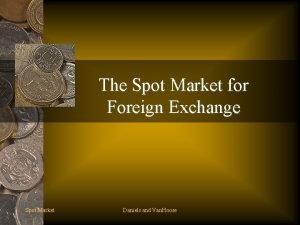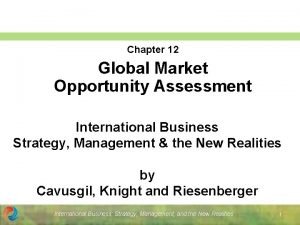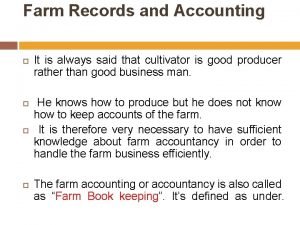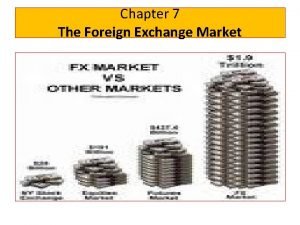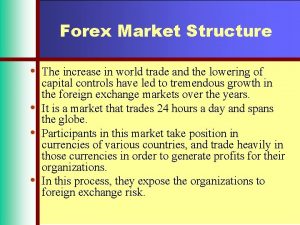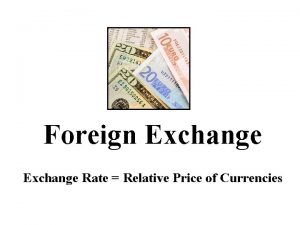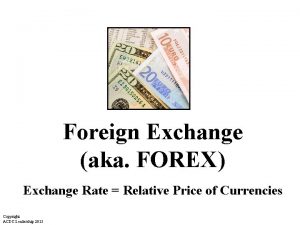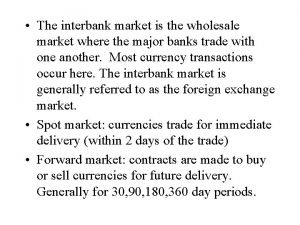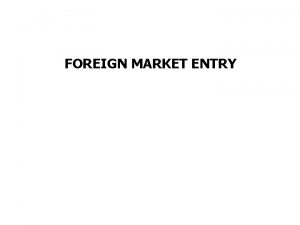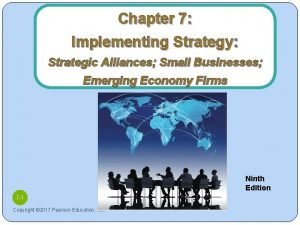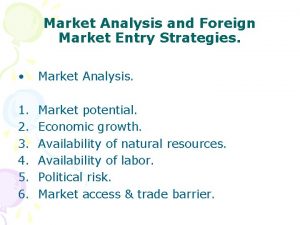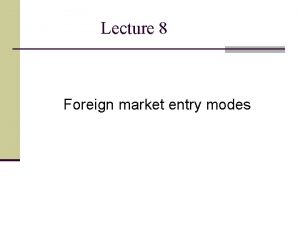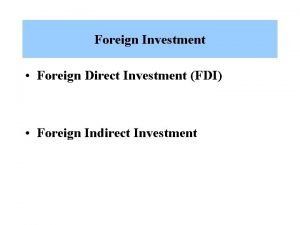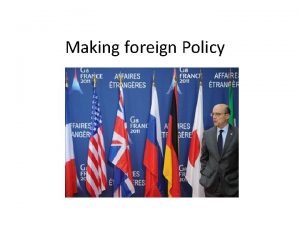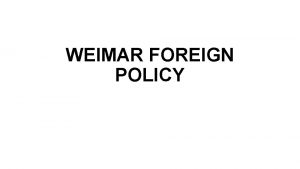FOREIGN MARKET ENTRY Foreign market entry analysis why















![Bring “I am very pleased with the decisions to approve the deal [with RVI]. Bring “I am very pleased with the decisions to approve the deal [with RVI].](https://slidetodoc.com/presentation_image_h/a5eb50ff71fd615e145894a5d44369f5/image-16.jpg)



















- Slides: 35

FOREIGN MARKET ENTRY

Foreign market entry analysis - why? 1 Expanding the firm profitably in international markets.

The starting point “The foreign direct investment process takes place in a setting in which knowledge is limited, and in which predictive capacity is small. Doubt and unreliability derive from ignorance, change, and a large number of unknown variables. ” Yair Aharoni (1966)

A typical entry sequence January 1997 “The German market looks interesting, let’s think about how to establish operations there. ” February 1999 “The German market is one of the world’s toughest markets, but we are determined to turn our local operations into a profitable business. ” July 2000 “The German operations are still not a sound business for us, but those who can succeed there can do it anywhere in the world. As an international firm, we cannot afford to stay out of the German market. ” “Besides, we are learning a lot. ”

Foreign market entry - four keys But should have started here! Why Bring Meet How Deciding to enter into Germany started here.

Foreign market entry initiation 1. Seller-initiated 2. Buyer-initiated (an unsolicited order) 3. Broker initiated (an entrepreneurial broker or agency) 4. Trade fair, chance encounter

Hong Kong toy manufacturers - source of first direct exports

Why Main reasons for entering a foreign market Percent

Why Be very specific about Why you enter a foreign market: 1. It helps you focus on the right activities. 2. The only way to decide whether to continue or not is to have clearly stated objectives and performance measures.

Bring What do we Bring? 1. 2. 3. 4. Unique product, service or concept e Patented technology m ro d Unique way of organizing syn n o i Brand p m ha c d l r Wo

Bring Product or service offering Revolutionary product or service Product or service that competes with established ones - look out! “Me too” Key decision parameters: 1. 2. 3. 4. 5. Major customers Market size (GDP, GDP/capita) Market growth Geographical and cultural proximity Political risk Incompatible ! ! Careful market selection

Bring Compatible but different concept The original Swedish whole grain vodka that has been carefully distilled according to ancient recipes

Bring Incompatible concept “We invested SEK 15 million in a part-owned company to establish Hemglass [‘Home ice cream’] in Germany. But it didn’t succeed. German housewives didn’t want to buy ice cream in the street. The German investment was a costly learning experience. Each market has to be treated separately. ” Torbjörn Ek, Hexagon

Bring Volvo trucks in the United States Why Bring Meet How Sell, improve profitability Superior truck, strategic insight, restructuring capability Different truck design, different industry structure, entrenched competitors, established brands Greenfield investment, then acquisitions (White, GM Heavy Trucks, Mack)

Bring When integration did not materialize in the US market Left with a structurally unattractive position in a very competitive market: Small market share Unclear strategic focus
![Bring I am very pleased with the decisions to approve the deal with RVI Bring “I am very pleased with the decisions to approve the deal [with RVI].](https://slidetodoc.com/presentation_image_h/a5eb50ff71fd615e145894a5d44369f5/image-16.jpg)
Bring “I am very pleased with the decisions to approve the deal [with RVI]. It means that after the closing we can immediately start the integration process. We are eager to quickly implement the strategy for the new truck group and the merged powertrain units. Our intentions are to have a functional management and organization in place by early next year. ” Leif Johansson, Volvo Group President and Chief Executive Officer, December 2000

Bring Press Release, September 28, 2001 “Mack and VTNA will maintain two separate headquarters, each with its own management and all of the functions necessary to deliver brandspecific, premium products and services to the brand's core markets. Meanwhile, a number of duplicative support functions which currently exist at both Mack and VTNA will be consolidated to increase the overall operating efficiency. ”

Bring “I am very pleased that responsibility for product development is turned back to the three brands Volvo, RVI, and Mack. Philippe Mellier at RVI shares my opinion - we need to be in direct contact with the market and in control over development of future models. ” Jorma Halonen, Head of Volvo Trucks, January 2002

Meet What do we Meet? Local customer preferences e m ro Local business practices and regulations d n y s n Entrenched local competitors pio m a h c d rl o W

Meet Entry barriers into an industry Entry barriers: Potential entrants Suppliers Competitors Substitutes 1. 2. 3. 4. 5. Economies of scale / learning effects Customer loyalty and switching costs Locked-up supplier and distribution channels Expected retaliation Regulations, patents, proprietary knowledge Buyers

Meet P&G’s entry into the Swedish diaper industry One-piece design increasingly popular P&G lowers price 30% Boy- and girl diapers Sampling TV-advertising

Meet The single most important problems (Swedish firms in the United States) 1. Conservative buyers 2. To create brand recognition 3. To build distribution network 4. Competition and price level 5. Product adaptation 6. Cultural differences 7. To find good managers

Meet Look for ´gate-openers´ Someone who welcomes rather than fights you

Meet The unavoidable consequence If you have nothing unique, the projection runs from disaster to status quo at the very best.

How do we enter? Which product(s)? What brand? What organizational form? Licensing Exports Agent Joint venture Wholly-owned subsidiary - Greenfield, acquisition What local activities? Sales Manufacturing Research and development

MARKET SELECTION

Market selection - the forgotten question Does the market fit our product and overall strategy?

Not all markets are good markets 1. Some markets offer a significantly better fit between what you Bring and what you Meet. 2. As the original business concept is exploited, increasingly distant and difficult markets are approached. Consider IKEA’s entry into the United States. . .

What did IKEA do? Introduced a new product Introduced a new manufacturing process Captured a new source of supply or raw materials Opened up a new market Created a new organizational form

IKEA in the United States Diverse and highly competitive market. Kitchenware, textiles and to some extent furniture must be adapted to local taste. Forced emphasis on design service, custom upholstery, home delivery, and in-home assembly. Marketing >10% of sales. Experiments with group bonuses. 4 th largest market, not profitable for some 10 years

IKEA impressions IKEA in PRC (1998) - Called IDYA (means make your home comfortable). 15 000 m 2, marble floors, extremely high rent, constant dry cleaning of furniture on display. Parking lot for only 40 cars, no “bollhav”. Wok pans and rice bowls added, length of shopping bag handles will be shortened. Otherwise, Swedishness galore (blue and yellow shirts, pedagogical signs describing Swedish life style to change Chinese way of furnishing homes). - Across the street from store, furniture dealers already sell sofas that are copies of Örgryte and Tomelilla… IKEA in Russia (1999) - ”It will take 25 years to furnish Russia; that is what we need to concentrate on. ” (Kamprad, Financial Times, August 18, 1998). - ”Blackmail” to get government to change tariff rates on imported furniture from weight to value. New tariffs around 20% (other countries around 3%). - Planned break-even in 10 years. IKEA in Japan (2002) - Outlets twice as expensive as before, 1 -1. 5 bn SEK. - Country head externally recruited.

Two breaking points in the international growth of the firm Foreign sales 2. Tightening operations, looking for a ‘second hit’ ”The Formula” 1. Finding a structured approach to foreign market entry and selection Time

SUMMING UP

Foreign market entry can be dangerous

Without trouble there is no profit. African (Hausa) proverb
 Why why why why
Why why why why Spot market in foreign exchange market
Spot market in foreign exchange market Gmoa international business
Gmoa international business Too foreign for home too foreign for here
Too foreign for home too foreign for here When entering foreign markets basic entry
When entering foreign markets basic entry Don't ask why why why
Don't ask why why why Why-why analysis
Why-why analysis Pengertian root cause analysis
Pengertian root cause analysis Leader follower challenger nicher
Leader follower challenger nicher Market segmentation lesson plan
Market segmentation lesson plan Conversion method in single entry system
Conversion method in single entry system Define new entry in entrepreneurship
Define new entry in entrepreneurship Difference between single entry and double entry system
Difference between single entry and double entry system Functions of foreign exchange market
Functions of foreign exchange market Objectives of foreign exchange
Objectives of foreign exchange Market structure in forex
Market structure in forex Structure of foreign exchange market
Structure of foreign exchange market Foreign exchange market features
Foreign exchange market features Stability of foreign exchange market
Stability of foreign exchange market Foreign exchange market example
Foreign exchange market example Foreign exchange market
Foreign exchange market International bond market
International bond market Foreign exchange market slideshare
Foreign exchange market slideshare Foreign exchange graph
Foreign exchange graph Exchange rate graph
Exchange rate graph Foreign exchange market
Foreign exchange market Forex shifter
Forex shifter The interbank market in foreign exchange is where
The interbank market in foreign exchange is where What is foreign policy analysis
What is foreign policy analysis Global saturation
Global saturation Market entry barriers
Market entry barriers Eclectic theory
Eclectic theory Waterfall and sprinkler strategy
Waterfall and sprinkler strategy Market entry modes for international businesses chapter 7
Market entry modes for international businesses chapter 7 Perfect competition def
Perfect competition def Market entry modes for international businesses chapter 7
Market entry modes for international businesses chapter 7

